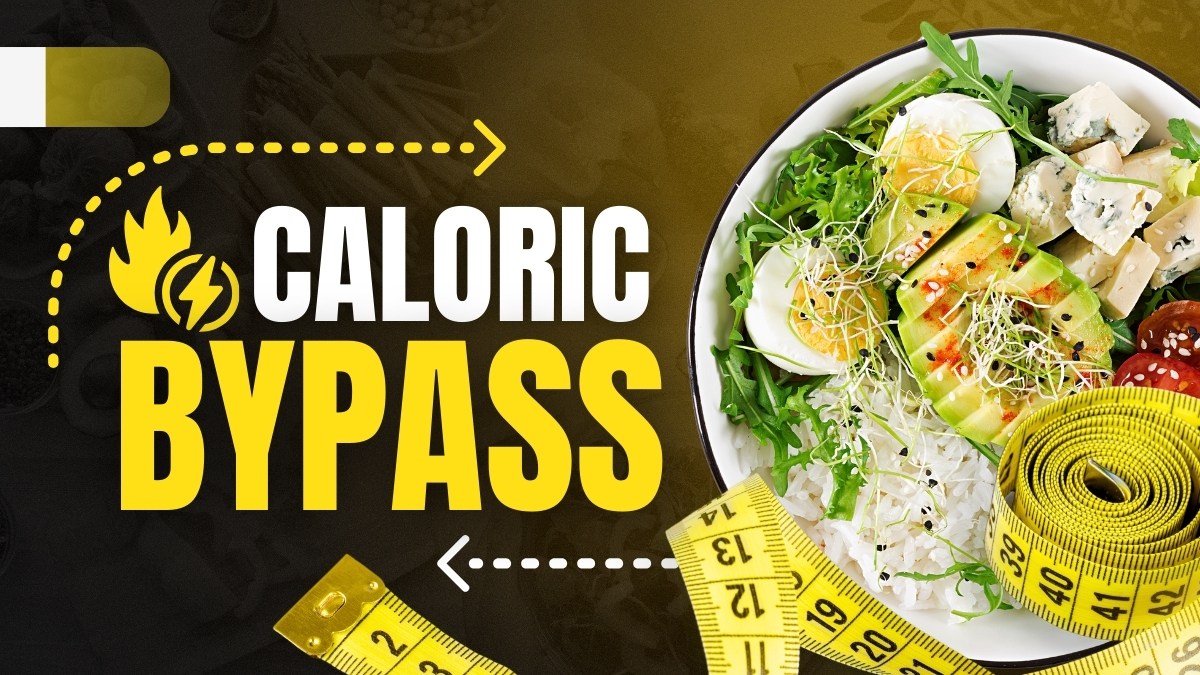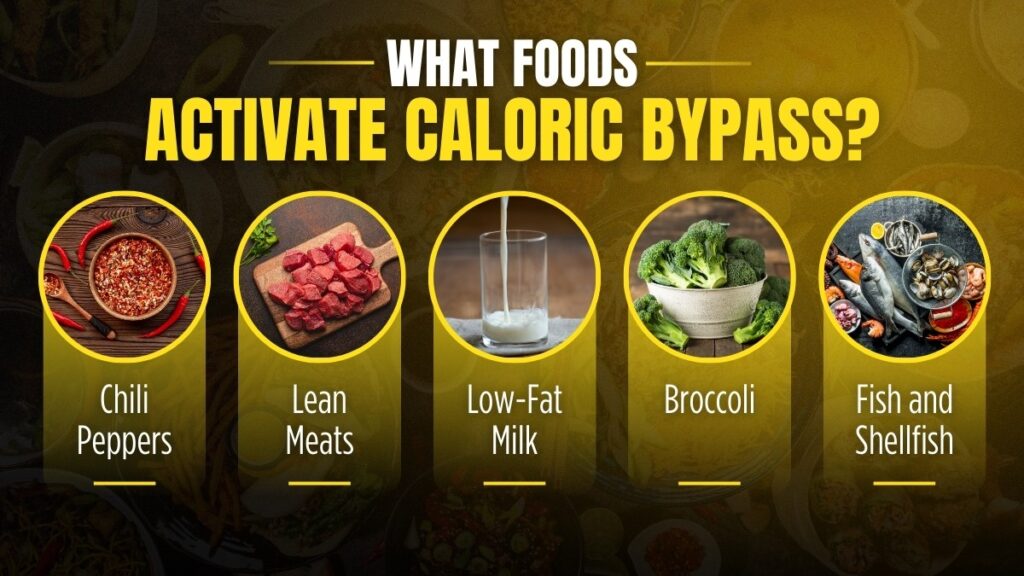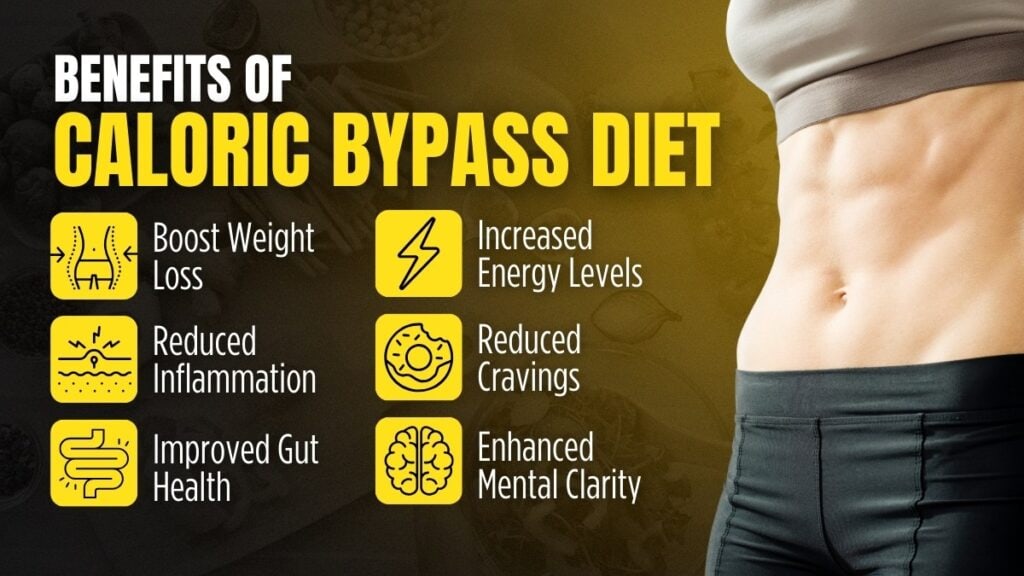
Have you ever wondered whether it’s possible to hack your metabolism, shed those stubborn extra pounds, and get fit effortlessly? Dr. Steven Gundry’s caloric bypass diet philosophy might just hold the key. He believes certain foods trigger inflammation and confuse your body, leading to weight gain and health issues.
Gundry claims you can unlock a healthier, leaner version of yourself by strategically avoiding those culprits. But is caloric bypass genuine? Can you outsmart your cravings and achieve lasting weight loss? Keep reading to get answers to every question you may have about caloric bypass.
What Is Caloric Bypass?
The caloric bypass diet builds upon the basics of a ketogenic supplementation and diet. It requires lectin-free and polyphenol-rich foods in your diet, practicing time-restricted eating, and stimulating mitochondrial uncoupling.
These lifestyle changes may reduce inflammation, improve gut health, and enhance the body’s ability to burn fat for fuel. The end goal is to optimize metabolic rate and promote longevity.
Mitochondrial Uncoupling
Usually, the energy produced in the mitochondria (your cells’ powerhouse) is used to generate ATP, which powers your body. However, in the case of mitochondrial uncoupling, the energy is released as heat. Sounds like a waste of energy, right? Except it is not.
The heat generated during mitochondrial uncoupling is put to good use by the body. Primarily, it contributes to maintaining body temperature by activating brown fat, especially in response to cold environments [1].
Some research suggests that mitochondrial uncoupling may improve insulin sensitivity and glucose metabolism, which is beneficial for preventing conditions like type 2 diabetes [2].
Mitochondrial uncoupling can also reduce the production of reactive oxygen species (ROS), the harmful byproducts of cellular respiration [2].
The Gundry Diet
The Gundry diet prioritizes gut health, starting with avoiding lectins and other inflammatory foods. Lectins are found in legumes and nightshade vegetables like tomatoes and peppers. Gundry argues that they can damage your gut lining and interfere with nutrient absorption.
Intermittent fasting also plays a big part in the Gundry diet by stimulating mitochondrial uncoupling. It can help regulate your hormones, improve insulin sensitivity, and promote fat burning [3].
Gundry often recommends supplements like prebiotics, probiotics, and digestive enzymes to support gut health and optimize nutrient absorption.
Key Components of the Gundry Diet
To truly unlock the keto code, Dr. Gundry suggests the following diet recommendations:
Plant-Based Diet
Start by adding whole grains, leafy greens, cruciferous vegetables, and other low-lectin veggies to your caloric bypass meal plan. Avocado and low-sugar fruits like olives and berries also have high nutritional value and are suitable.
Healthy Fats
Typical benefits of this food group include keeping you satiated, supporting hormone production, and contributing to your overall health. Popular oils like coconut, olive, and avocado will do. You can also spice things up with oils from nuts and seeds like walnuts and almonds, while many people like to add keto ACV gummies to their diet as well.
High-Quality Protein
Pasture-raised meats, wild-caught fish, and A2 milk are protein-dense foods that may support your diet goals.
Beef, poultry, and lamb from animals raised in a natural environment will cover the meat category. For fish, you can’t go wrong with salmon, tuna, or sardines.
If you’re wondering what A2 milk is, it’s milk from cows with a specific type of protein (beta-casein) that’s easier to digest [4].
Limiting Processed Foods
Even if you’re not on a caloric bypass diet, processed foods should be consumed in moderation. That said, Gundry strongly advises against packaged snacks (chips, cookies, crackers), refined grains (white bread, pasta, pastries), and drinks with added sugars (soda, sweetened juice, or beverages). Yet, these are only a few popular options among caloric bypass foods to avoid.
What Is the Caloric Bypass Switch?
Dr. Steven Gundry uses the term “calorie bypass switch” to describe the process by which the body changes its energy source and starts using fat as fuel instead of glucose from food.
Adopting the Gundry diet allows you to “bypass” the typical weight loss approach of counting macros or calories and achieve better health by optimizing your body’s energy production.
What Foods Activate Caloric Bypass?
Now that you have a general idea of what the diet involves, let’s dig deeper into natural caloric bypass foods to eat that can activate mitochondrial uncoupling:

1. Chili Peppers
Packed with capsaicin, a compound that can boost metabolism and promote fat-burning, chili peppers fit well into Dr. Gundry’s caloric bypass concept. They also add flavor without the extra calories that may offset your daily caloric intake.
What’s more, capsaicin is a popular ingredient in the best supplements for weight loss female and male dieters often take.
2. Lean Meats
Gundry also recommends pasture-raised meats. Why? They have a better fat profile and are free of antibiotics and hormones. So, lean beef, poultry, and lamb cuts should be your go-to meats.
3. Low-Fat Milk
Conventional milk will not do here. Look for A2 milk or other caloric bypass foods for weight loss, such as almond or coconut milk.
Another dairy product you may consider is organic cottage cheese. Just make sure it is made from grass-fed cows to minimize potential lectins and maximize nutrients.
4. Broccoli
Cruciferous veggies like broccoli are low in lectins and filled with essential nutrients. In addition, broccoli is an excellent source of fiber, which supports gut health and helps you feel full faster and for longer.
5. Fish and Shellfish
If you want to learn how to activate caloric bypass with protein foods, opt for fish. They’re rich in protein and omega-3 fatty acids and may promote fat-burning and reduce inflammation.
DNP in Caloric Bypass: What You Should Know
DNP is short for 2,4-dinitrophenol and has no place in a healthy caloric bypass diet. It is a chemical that was used as a weight-loss drug in the 1930s. However, it was quickly banned due to its severe side effects and its potential to cause death [5].
DNP disrupts mitochondrial coupling and the body’s energy production process. While users may experience rapid weight loss with the compound, it may cause a dangerous increase in body temperature. Potential organ damage is also a common side effect of DNP.
How Much Weight Can You Lose in a Caloric Bypass Diet?
Dr. Gundry doesn’t promise a specific number. As with any weight management approach, evidence from followers of the caloric bypass suggests varying degrees of weight loss success.
In addition, everyone is different, and results will depend on how consistently you follow the diet, starting weight, metabolism, and levels of daily physical activity (whether you prefer Pilates, bodybuilding, running, or other workouts).
You should also remember that the caloric bypass emphasizes clean eating and overall health improvements, not just weight management, as seen with medications such as Ozempic weight loss prescriptions.
Benefits of the Caloric Bypass Diet
Although scientific research specifically on the caloric bypass diet is limited, most users highlight several potential benefits:

- Weight Loss: By eliminating inflammatory foods, the body is more efficient at burning fat for fuel.
- Reduced Inflammation: This can improve autoimmune diseases, joint pain, and digestive issues.
- Improved Gut Health: Focusing on prebiotic-rich caloric bypass foods for weight loss fosters a healthy microbiome, which is crucial for overall well-being.
- Increased Energy Levels: Many users report feeling more energetic and less sluggish after adopting this dietary approach.
- Reduced Cravings: The diet may help curb your appetite by stabilizing blood sugar and reducing inflammation.
- Enhanced Mental Clarity: Some followers claim improved focus and cognitive function.
Disadvantages of the Caloric Bypass Diet
Here are some potential downsides of the caloric bypass diet:
- Restrictive Nature: The diet eliminates many common foods, making it challenging to follow long-term.
- Nutrient Deficiencies: Cutting out entire food groups can increase the risk of nutrient deficiencies if not carefully managed with supplements like methylated multivitamins.
- Limited Scientific Evidence: Much of the support for caloric bypass foods for weight loss is anecdotal, with limited scientific research to confirm their long-term effectiveness and safety.
- Potential for Disordered Eating: The diet’s emphasis on “good” vs. “bad” foods can create an unhealthy relationship with food and potentially trigger disordered eating patterns in susceptible individuals.
- Cost: Adding more organic produce and specialty ingredients to your caloric bypass meal plan can be expensive. Those on a strict budget may find natural caloric bypass foods inaccessible.
Expert Insights
Is caloric bypass real? Well, Dr. Steven Gundry, the creator of the caloric bypass approach, is a real believer and states that this dietary philosophy is “not about deprivation; it’s about making smart food choices that nourish your body and promote longevity” [6].
He emphasizes the importance of avoiding lectins, which he believes disrupt gut health and contribute to inflammation [6].
While limited scientific research exists, experts in functional medicine and nutrition have weighed in on its principles.
One example is Dr. Will Cole, a leading functional medicine practitioner. He supports reducing inflammatory foods for optimal health, echoing Gundry’s emphasis on gut health and personalized nutrition [7].
Online Consensus
The online community has a mix of enthusiastic supporters and skeptical critics. In a short thread on r/cfs, Laura168 found the diet helpful for her digestive issues. Carrie_likes_health noticed improvements in her digestion, which positively impacted her overall well-being. She also found that she could tolerate small amounts of lectin-containing foods occasionally.
However, Slow_Ad1284 tried the AIP diet (similar to the lectin-free diet), and several other elimination diets didn’t result in any benefits whatsoever. On r/askfitness, rikoclawzer says the diet seems super restrictive and dangerous.
 11 Niche Experts
11 Niche Experts
 100+ Product Reviews
100+ Product Reviews
 50+ Tested Products
50+ Tested Products
At BestDaily, our mission is simple: to help you make confident, informed decisions about the products that impact your daily life. Whether you're searching for wellness essentials or lifestyle upgrades, we combine hands-on testing with expert analysis to highlight what truly works.
FAQs on the Caloric Bypass Diet
Let’s see what else people often ask about the caloric bypass:Why Is Caloric Restriction Not Recommended for Humans?
While caloric restriction has shown some benefits in animal studies, it’s generally not recommended for humans due to potential negative consequences [8]. Following an extreme caloric bypass diet or severely restricting your daily caloric intake can lead to nutrient deficiencies, hormonal imbalances, muscle loss, fatigue, and disordered eating patterns.
A sustainable and healthy weight loss program should emphasize nutrient-dense foods, balanced meals, and mindful eating habits.
How Much Weight Will I Lose if I Eat 1200 Calories a Day and Burn 500?
Creating a daily deficit of 700 calories could “theoretically” lead to a weight loss of about 1.4 pounds per week. This is because one pound of fat is roughly equivalent to 3,500 calories. However, weight loss is not simple arithmetic, and our bodies work differently. Prioritize a balanced, low-calorie diet, and consult a healthcare professional for personalized advice.
How Do You Switch Metabolism To Burn Fat?
Your metabolism is not a light switch you can quickly turn on and off. That said, you can make choices that stimulate your body to use fat for fuel more efficiently. You can achieve this by increasing protein intake, prioritizing strength and high-intensity interval training, getting enough sleep, and taking supplements that promote weight loss.
What Is the Switch Weight Loss Procedure?
Also known as duodenal switch, it is a bariatric surgery (like gastric bypass) that helps people with severe obesity or a body mass index (BMI) of 40 or higher to lose weight fast. It involves removing a large portion of the stomach and rerouting food to bypass a significant portion of the small intestine. With this surgery, patients can limit their calorie intake and reduce nutrient absorption [9].
Conclusion
Dr. Steven Gundry’s caloric bypass diet has gained a lot of attention for its unique approach to weight loss and overall health. To get started, you will need to avoid lectins and other inflammatory foods and majorly restructure your diet routine and lifestyle.
Personal accounts and experiences from those who follow the diet suggest potential benefits like weight loss, reduced inflammation, and increased energy. However, limited scientific research supports these claims.
So, before you ditch counting calories or start stocking caloric bypass foods, carefully weigh the pros and cons. Then, talk to your doctor, and together, you can decide whether its principles align with your individual needs and lifestyle.
Here’s a summary of key takeaways:
- Focus: Eliminating lectins and inflammatory foods to optimize keto benefits and unlock mitochondrial uncoupling.
- Potential Benefits: Weight loss, reduced inflammation, and improved gut health.
- Potential Drawbacks: Restrictive, potential for nutrient deficiencies, and is backed by limited research.
- Recommendation: Consult a healthcare professional before starting.

